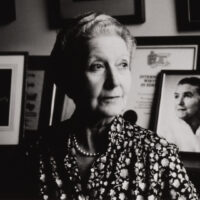
American Composers Orchestra Reads Haddad’s “Maelstrom”
Saad Haddad, USC '14, shares his experience having his orchestral work read by the American Composers Orchestra.
By
In 2nd grade, my teacher, Mrs. Silverman, had our class write short biographies about visionaries from different fields every month of the school year. One month it was about science, so I wrote about Albert Einstein. In another, it was about literature, so I wrote about John Steinbeck. Then there was the music month, and this is when my life changed in an instant.
In the beginning of that month, Mrs. Silverman took our second grade class to the school library, where the tables were strewn with picture books about the great composers that we know and love from the 17th to 19th centuries. It seemed like just another day at the library until I opened the book about Mozart and read about his very early excursions into music. And that, I remember very clearly, is when I began to panic: “This guy was 5 when he wrote his first piece, and I’m already 7!” From that moment on, I knew what the rest of my life was going to be about.
Flash forward about thirteen years, and I’m still on the same journey that I sought when I was in the 2nd grade. When I was 18, I began sketching (on manuscript paper!) my second full orchestral piece. At 19, I finished it. And at 20, I finally heard Maelstrom performed by Professor Donald Crockett and the USC Symphony. That night was one of the most exciting moments of my life, not only for myself but also for my five peers who shared the stage with their orchestral works. This Maelstrom wasn’t done whirling though. About a month prior to the USC premiere, I received a simple phone call from the least simple of places: “Saad, would you like to come to New York? The American Composers Orchestra is planning to read your piece in a couple months.” Michael Geller, the executive director of the American Composers Orchestra (ACO), finished his sentence, and my heart began to race as I stood in a state of euphoria between USC’s music complex and the cinema school, my two creative havens. All those months of straining my back over my desk, etching in dots and lines on a manuscript, had paid off. I was going to New York!
Backtrack: The American Composers Orchestra is a freelance 65-piece orchestra based in Manhattan that is dedicated to reading and performing brand new contemporary classical music. Every year, the orchestra hosts the Underwood New Music Readings, which selects orchestral pieces of six American composers out of about 200 full orchestral scores that are submitted by composers across the country.
On April 8, I arrived at the DiMenna Center where I met the other five composers selected for the readings, one of whom I’ve known since I was in high school and who many of my USC colleagues know: A.J. McCaffrey. The first reading session lasted 3 hours, and my piece was the last one. The orchestra hall wasn’t really a conventional concert hall, but rather a rehearsal space designed to cater to public performances. Guests in attendance sat in a semi-circle around the orchestra on the stage, with the panel of mentor composers and myself seated in a line in front of the orchestra. This year the panel of mentor composers included Christopher Theofanidis, Joan Tower, Robert Beaser, and Derek Bermel.
For some reason (I’ve yet to understand why), I wasn’t nervous. I didn’t have my normal jitters right before a piece of mine is rehearsed or performed. I didn’t start to sweat. I felt like I was prepared for what was about to happen, and I was. Without Professor Donald Crockett and the USC Symphony, I wouldn’t have felt this way, and for that I am duly grateful. After the orchestra ran through the piece for the first time, I got up, took the mic, had some comments ready to go, and sat down without much hesitation.
It wasn’t until after the session that the nerves began to set in. This was the part where the principal musicians from the orchestra critiqued our orchestral parts. This kind of opportunity was a real scarcity. It’s probably more rare for composers to get this kind of discussion about their orchestral parts than to have the piece played in the first place! Some insights that I gained from musicians included changing the sizes of noteheads (turns out that the 8mm font MOLA advises to use is too big on 10×13 sized parts) and the use of 8va markings in the piano part (if you want both hands to be 8va, notate those markings over both staves instead of marking “both hands 8va” above the treble staff). After that enlightening discussion, the mentor composers gave their initial reactions to our orchestrations. The main discussion about my piece centered around what Joan Tower called a “sound profile,” meaning that each section of the music should have a specific timbral context that the main juice of the music “sits” in. This kind of thinking prompted me to add subtle suspended cymbal rolls throughout the softer moments of my piece in order to create a subliminal level of tension as the music dies down.
Day 2: After a series of workshops on engraving, copyright, and social media, it was time for the formal public reading of our pieces, which had over 100 people in attendance. Before the reading of my piece, I took the mic again, this time directing my words to the audience. Much of my prose was programatic, in an effort to guide the listener’s ears with a visual landscape of what they “should be envisioning” on the first listen of Maelstrom. In terms of new music, I believe that telling an audience, “This piece is whatever you want it to be,” allows listeners to misconstrue a composer’s intention, though it also creates an aural environment that doesn’t have to be more abstract than it already is. That being said, I think it is obligatory for composers to let an audience know what they intended, at least on an extramusical level, especially for pieces that will likely only be heard once in a listener’s lifetime.
It took one year and ten months from the inception of Maelstrom to get to this moment. I felt relieved yet exhausted, euphoric but still sad. As I got up to acknowledge the applause, I felt the back of my mind start racing with vague thoughts about the future, thoughts resembling those of my 7-year old self when I had first opened that book 13 years ago. This experience has taught me that there is great hope for the creation of fresh and inspiring orchestral music. As long as orchestras continue to survive, there will always be opportunities for composers to share their visions of what this medium can offer going forward in the 21st century.




